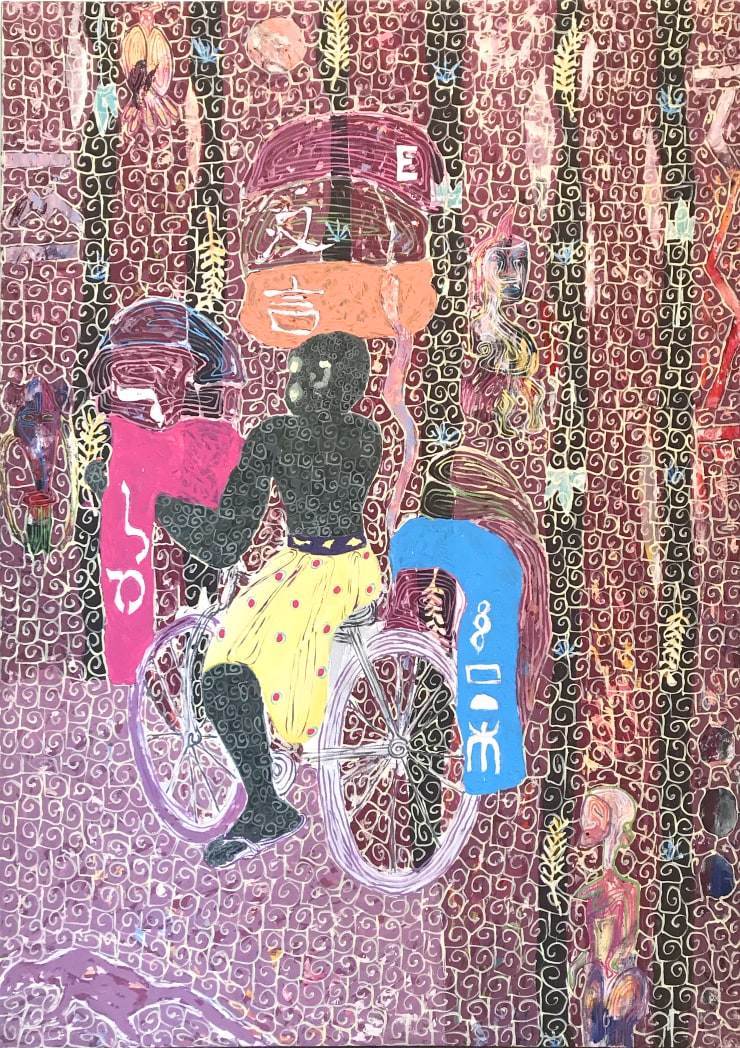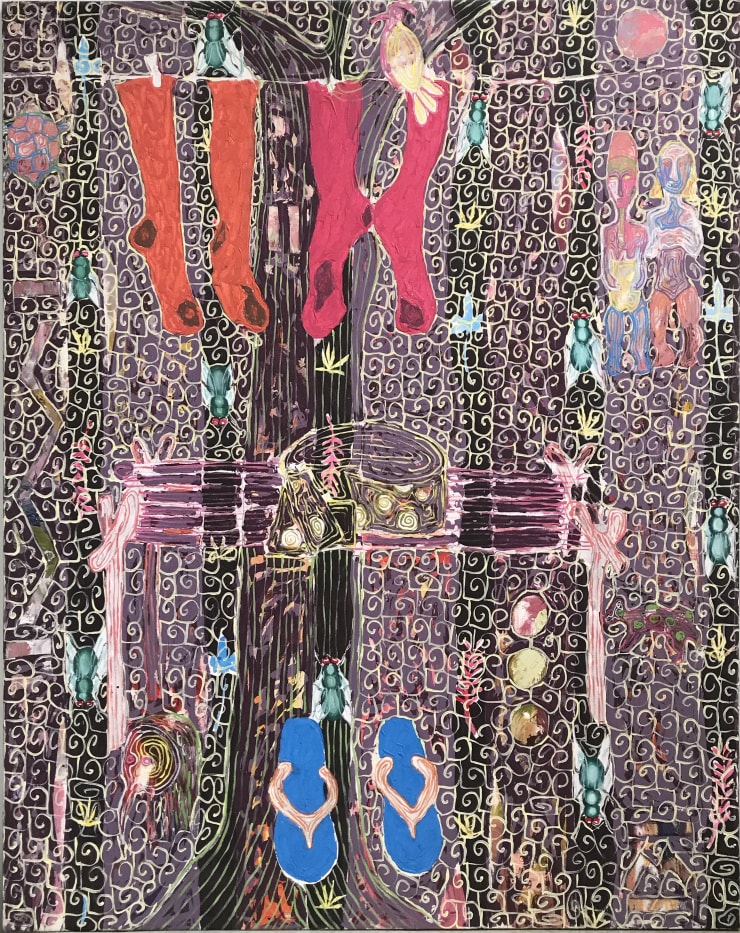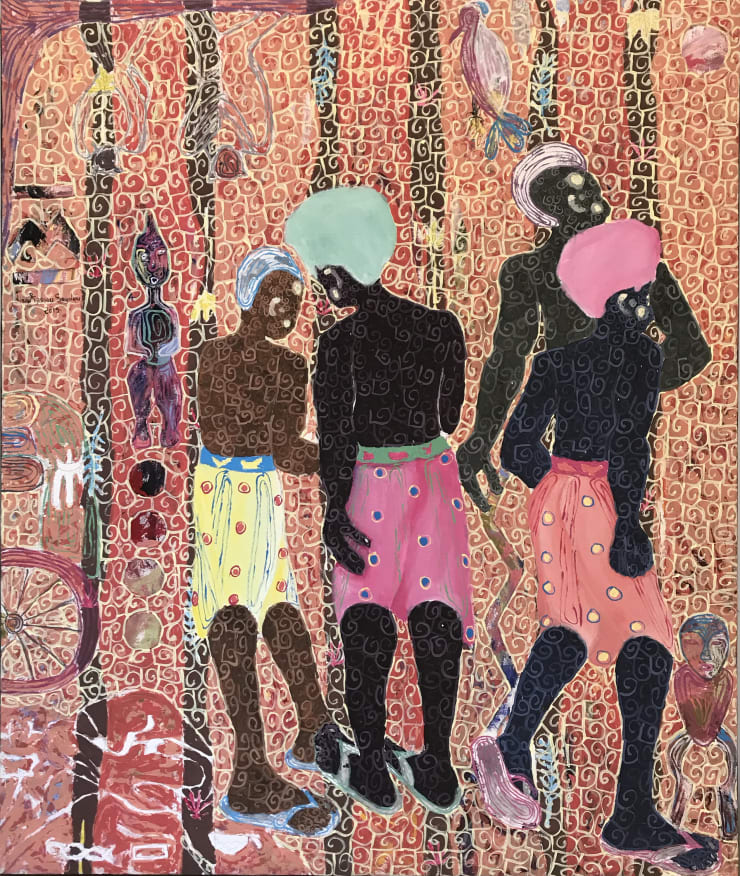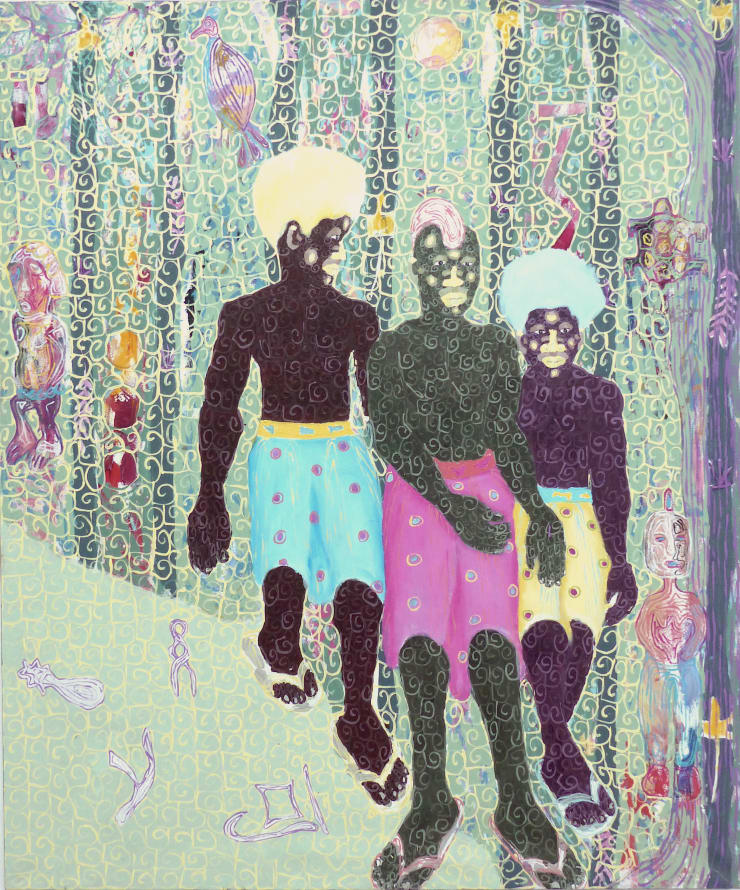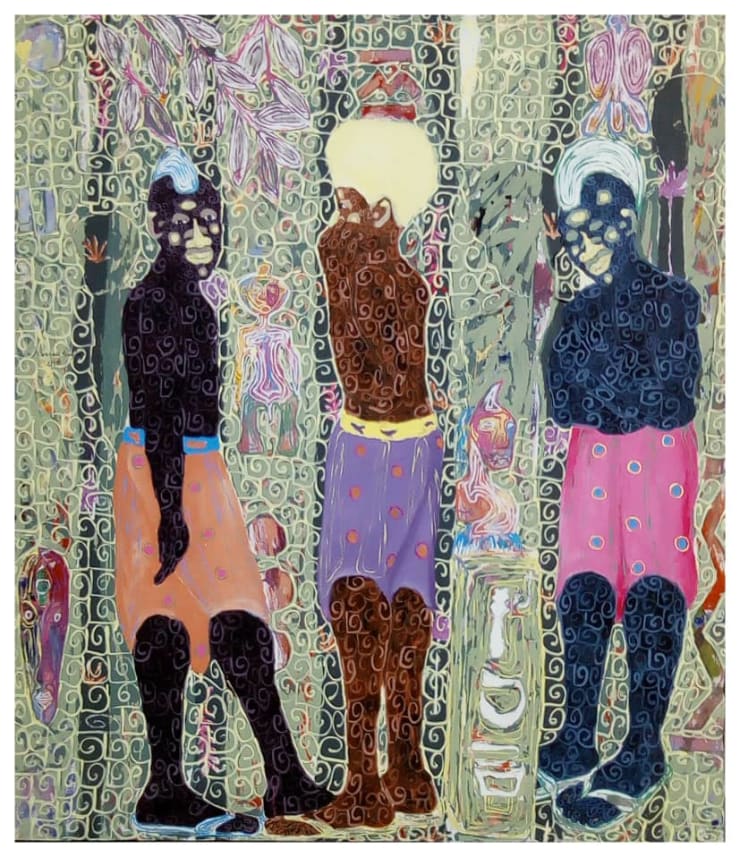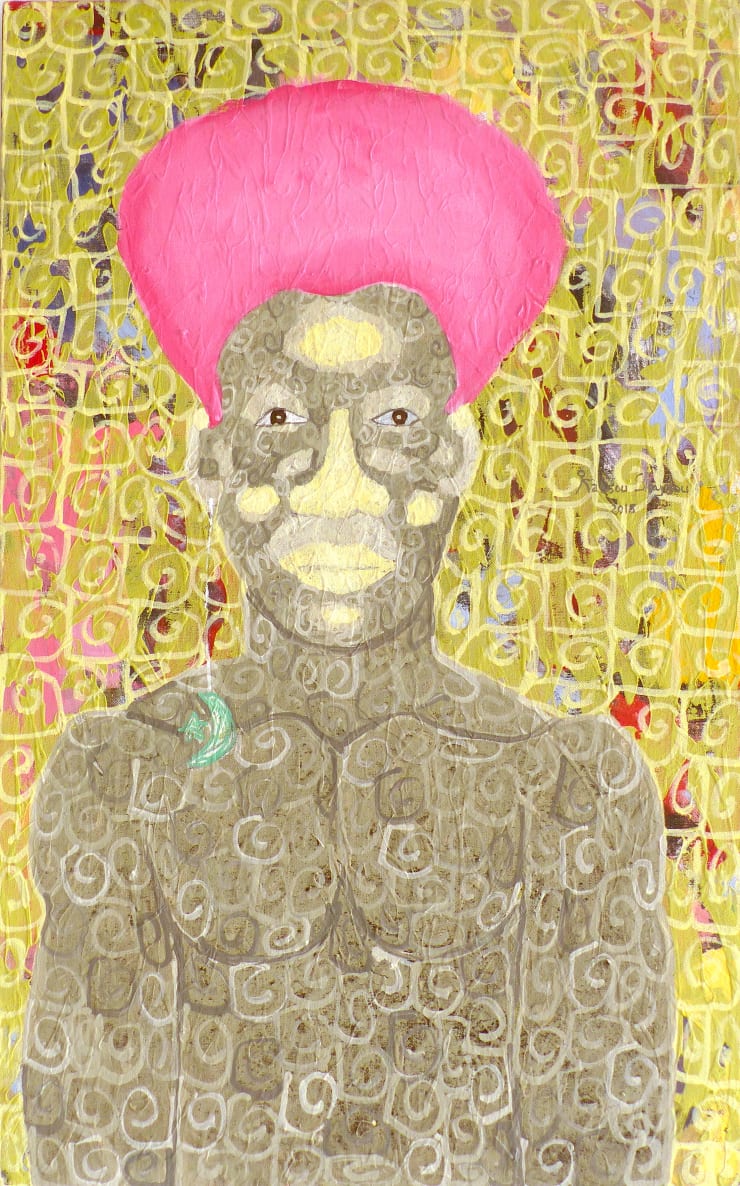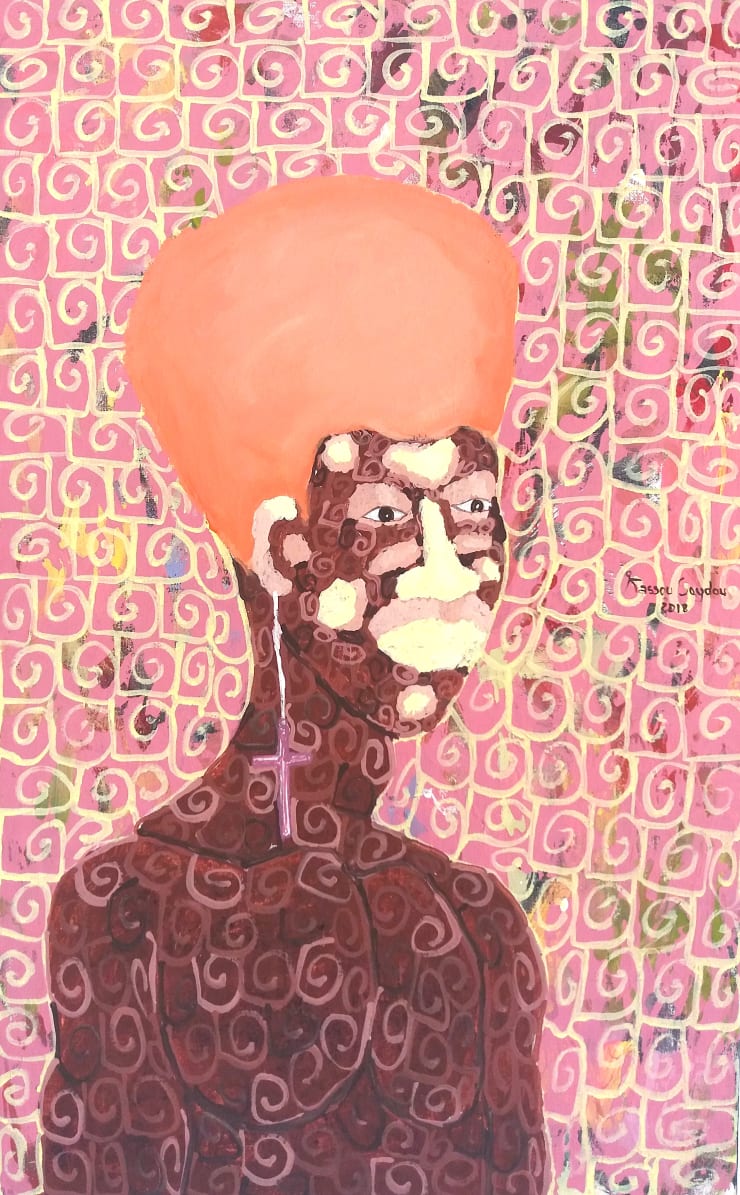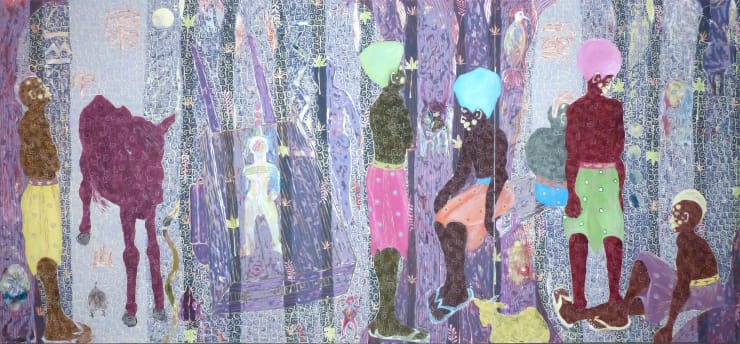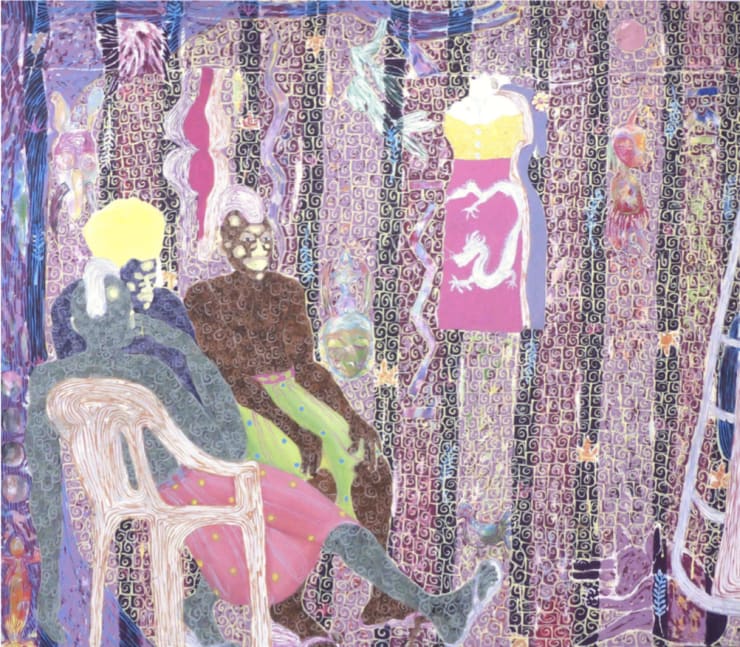-
En savoir plus sur l'artiste
This week, we invite you to discover Ndekane, a work by Kassou Seydou, a Senegalese artist born in 1971 in Ziguinchor.
Delphine Lopez, director of Galerie Cécile Fakhoury in Dakar, offers us a personal lecture of this work. -
At the beginning of winter 2019, Kassou Seydou is completing a series of paintings that complete and conclude a body of works he initiated for his solo exhibition Mbindoum Kaw Gue at the gallery in Dakar, Senegal. "Mbindoum kaw gue" means in Wolof "the story that is being written" and could just as well summarize Kassou Seydou’s aesthetic research, whose serial approach explores themes that follow and respond to each other like chapters of an ongoingvisual narrative.
In this series of paintings, one in particular caught my eye, Ndekane. It must be said that the hues of this work are quite unusual in the artist's palette - a variation of light blues, water greens, polar mauves. Colours of the wave for a painter of fire. In his studio, Kassou Seydou paints under the sun's rays in Keur Massar, a suburb of Dakar. The bright natural light is atool influencing both the construction of the pictorial space and the intensity of the colours. The sun as an all-powerful filter in art as well as in life.
As always with Kassou Seydou, the eye requires to decipher a space it is not used to see. Sometimes in the artist’s works, this remarkable phenomenon occurs, which consists inan abstraction of the gaze due to the high density of figurative forms. One then observes the succession of coloured stripes in the background, the figures of the characters and their luminous clothing, the curvilinear lines that bring everything together, and one could see it as a scene in its broad outline. Yet the depth of Kassou Seydou's works requires time to accommodate. No perspective lines, no play of light and shadow that come to structure the image as in classical painting, but a subtle balance between the proportions of the characters and their placement in the frame. Each element can only be understood in the space of the canvas in interdependence with each other. Here, the aesthetic principle reveals the artist's vision and the message of the work.
-
Kassou Seydou seeks to paint contemporary Senegalese society by inserting into sometimes complex scenes the clues of a path to be followed towards harmony; that of a world where men and nature would cohabit beyond the relations of predation and consumption; that of a world where men would give faith in the teachings of nature and the past, in the richness of a heritage, in the splendour of a land we are reminded of throughthe animal and plant figures that populate the canvas.
"Ndekane": "to entrust the custody of someone or something to someone you trust" in Wolof. The scene is both literal and metaphorical. On the right, the child joins the man who welcomes him with open arms. In the foreground, to the left of the work, a man is standing upright, leaning on a tree which he embraces with his arms in a movement reminiscent of the man's movement towards the child. In this tree, geniuses and fetishes are watching. They are the flow of the trunk, the presence of the scene and the memory of time. Ndekane reminds me of an initiatory passage, the cryptic power of a « Bois sacré » [sacred wood]ceremony that marks a boy's entry into the life of a man and which is traditionally practiced by the Diola ethnic group in Casamance in southern Senegal, where Kassou Seydou is from. Ndekane is also a representation of time, a cyclical temporality where the future cannot be without the recognition of the past and the anchoring in the present.
When he talks about his work, Kassou Seydou often evokesthe fact that everyone’s destiny is written to the world. He tries, in an absolute gesture, to make them visible through the matrix of curvilinear motifs that he extends from canvas to canvas, like a contemporary script. These lines also make me think of time, more preciselyof a certain way of apprehending time that one can encounterin West Africa when observinglife in the interstices of global metropolises. Finally, Kassou Seydou's message remains no less universal, like the signs borrowed from various cultures, Chinese, cabbalistic, whose symbolic and signifying force goes beyond mere geographical location. Here, the message is indeed one of anchoring and transmission. As a meditative image, Ndekane is a time of thought, a parenthesis to reinvent our being in the world, with others and for others; with the world and for the world.
-

-
Œuvres disponibles / Available Works
-
 Kassou Seydou, Guidon guidon, 2019
Kassou Seydou, Guidon guidon, 2019 -
 Kassou Seydou, Ça sent du camembert in the African bantamba, 2019
Kassou Seydou, Ça sent du camembert in the African bantamba, 2019 -
 Kassou Seydou, Bayi xou nioutji khel, 2019
Kassou Seydou, Bayi xou nioutji khel, 2019 -
 Kassou Seydou, Bi walla bi, 2019
Kassou Seydou, Bi walla bi, 2019 -
 Kassou Seydou, Sentou yone, 2019
Kassou Seydou, Sentou yone, 2019 -
 Kassou Seydou, Ndekane, 2019
Kassou Seydou, Ndekane, 2019 -
 Kassou Seydou, Bou for yombe, toki yomb ( Si ramasser devient facile, se courber devient difficile), 2019
Kassou Seydou, Bou for yombe, toki yomb ( Si ramasser devient facile, se courber devient difficile), 2019 -
 Kassou Seydou, Les richesses de Je-ne-sais-où, 2019
Kassou Seydou, Les richesses de Je-ne-sais-où, 2019 -
 Kassou Seydou, Banc diakhlé, 2019
Kassou Seydou, Banc diakhlé, 2019 -
 Kassou Seydou, One Human, One World #1, 2018
Kassou Seydou, One Human, One World #1, 2018 -
 Kassou Seydou, One Human, One World #2, 2018
Kassou Seydou, One Human, One World #2, 2018 -
 Kassou Seydou, One Human, One World #3, 2018
Kassou Seydou, One Human, One World #3, 2018 -
 Kassou Seydou, Dar Salame, 2018
Kassou Seydou, Dar Salame, 2018 -
 Kassou Seydou, Les Bras croisés, 2018
Kassou Seydou, Les Bras croisés, 2018 -
 Kassou Seydou, Red Bantamba (l'arbre à palabres rouge), 2018
Kassou Seydou, Red Bantamba (l'arbre à palabres rouge), 2018 -
 Kassou Seydou, Blue Bantamba (l'arbre à palabres bleu), 2018
Kassou Seydou, Blue Bantamba (l'arbre à palabres bleu), 2018
-
Focus sur / Ndekane, Kassou Seydou: #1
Past viewing_room


